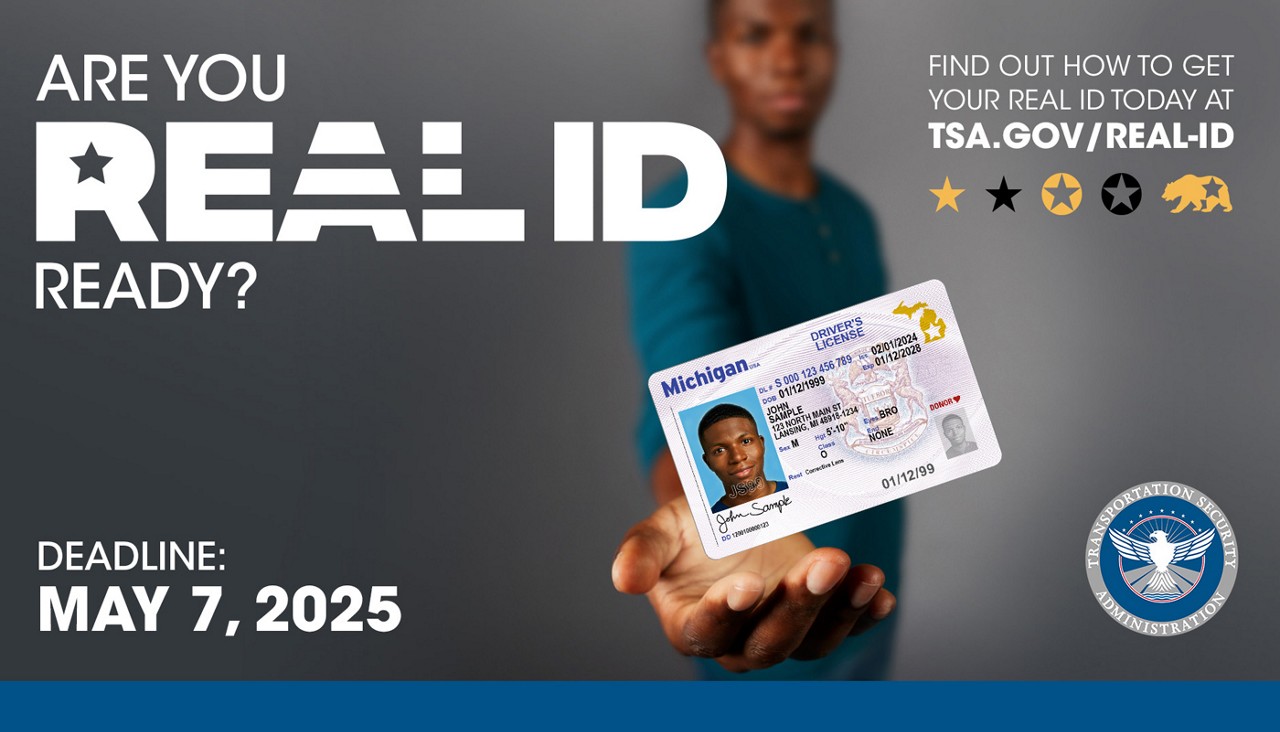To ensure you receive the best service possible,
please enter your zip code below:

As of May 7, 2025, travelers will need a REAL ID-compliant driver’s license or state-issued identification card to board domestic flights in the United States. This change is part of a federal initiative to enhance security standards nationwide. Here's what you need to know to be prepared.
A REAL ID is a driver’s license or state-issued ID that meets stricter security standards set by the federal government under the REAL ID Act of 2005. It’s designed to make identification more reliable and secure. On May 7, 2025, you’ll need a REAL ID to board domestic flights within the U.S. and to enter federal buildings or military bases. If you don’t have one, you’ll need another form of identification, such as a passport, for these activities. The upgrade ensures all state-issued IDs are consistent, secure and harder to tamper with.
Your driver’s license does more than let you drive—it’s a go-to form of ID for boarding domestic flights and accessing secure facilities. For decades, however, each state set its own rules for issuing licenses, creating a patchwork of security standards. These inconsistencies opened the door to fraud and identity theft. The REAL ID Act, passed by Congress in 2005, establishes a unified, nationwide standard for driver’s licenses and state IDs. REAL IDs feature anti-counterfeiting technology, strict identity verification and tamper-resistant designs. The goal is to close security gaps while offering convenience—no need to carry a passport for domestic flights.

Air travel within the United States will be the most common situation where people will need identification with REAL ID, but additional situations will also require it. Following May 7, everyone visiting a military base, nuclear facility or federal building that requires identification will need to be REAL ID-compliant.
Currently, you will not need a REAL ID to:
Traveling overseas next year? Learn about the new UK ETA (Electronic Travel Authorization) updates and plan your perfect trip like a pro.
Read moreAll 50 states, the District of Columbia and the five U.S. territories are now issuing REAL ID-compliant driver’s licenses and identification cards. To apply for a REAL ID, you must visit a Department of Motor Vehicles Office in person in the state where you live. Be prepared to bring several documents that meet DMV requirements to prove your identity. At a minimum, you’ll need to provide:
Some states may impose additional requirements, so use the following links to find specific information for your state:

Most states mark REAL ID-compliant driver’s licenses or identification cards with a gold or black star in the upper corner. This star indicates that the card meets the federal security standards established by the REAL ID Act. If your ID does not have one of these stars, it is not REAL ID-compliant and cannot be used to board domestic flights or access certain federal facilities starting on the enforcement date.
If you want to keep your current driver’s license (so long as it hasn’t expired), it will continue to authorize your motor vehicle operation, but you won’t be able to fly domestically without a separate REAL ID card or an alternate form of approved documentation.
Mobile Driver’s Licenses (mDLs) are digital versions of your driver’s license or ID card and they’ll also show if they’re REAL ID-compliant, just like the physical cards. On May 7, 2025, the Transportation Security Administration (TSA) and some federal agencies will only accept mDLs for official use if they’re issued by states that have TSA approval. Keep in mind that not every federal agency accepts mDLs, so it’s smart to carry your physical REAL ID card too. You can find out more about REAL ID-compliant mDLs on the Department of Homeland Security website.

Only adults, ages 18 and up, will be required to show a REAL ID to board a domestic flight. Some airlines do require specific identification for minors (such as a certified birth certificate) in situations where there is no fare or it is discounted.
As an alternative to a compliant driver’s license or identification card, TSA accepts several other forms of identity documents, including valid passports and passport cards. The TSA website has additional information on approved forms of identification for boarding aircraft.
The rules for international flights as well as for border crossings into Canada and Mexico haven’t changed: Passports are always required for both minors and adults.
No. REAL ID is a national set of standards to improve a state-issued, federally recognized form of identification; it is not a national identification card or part of a national database. All records (and access to those records) remain at the state level.
Getting prepared for REAL ID compliance is a practical step to ensure seamless travel and access to secure locations. While the process may require a trip to the DMV and a few extra documents, the payoff is a more secure, standardized form of identification that aligns with modern safety needs. Whether you opt for a physical card or explore a mobile driver’s license, staying informed about your state’s requirements will keep you ahead of the curve. While passports remain the standard for international travel, REAL ID represents a significant advancement for domestic identification—don't be left grounded.
Explore, discover, wander...
Connect with a trusted AAA Travel Agent to make the most of your membership—unlock exclusive benefits and savings for an unforgettable and budget-friendly vacation.